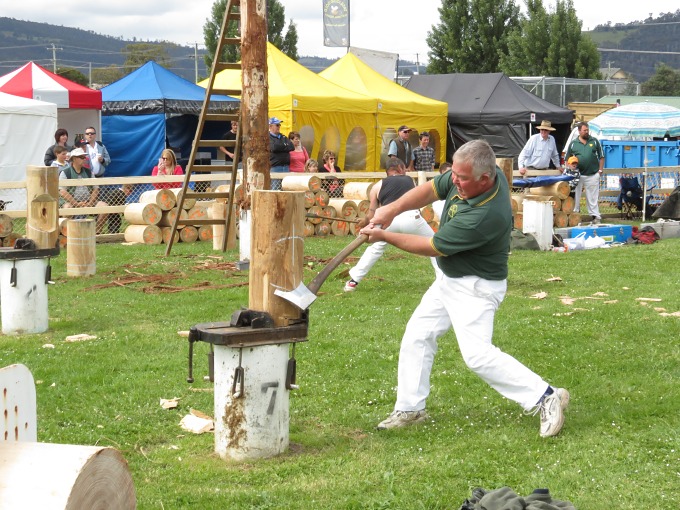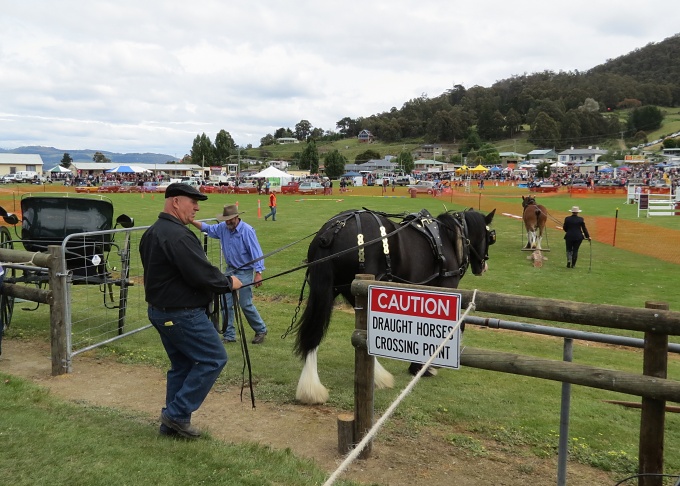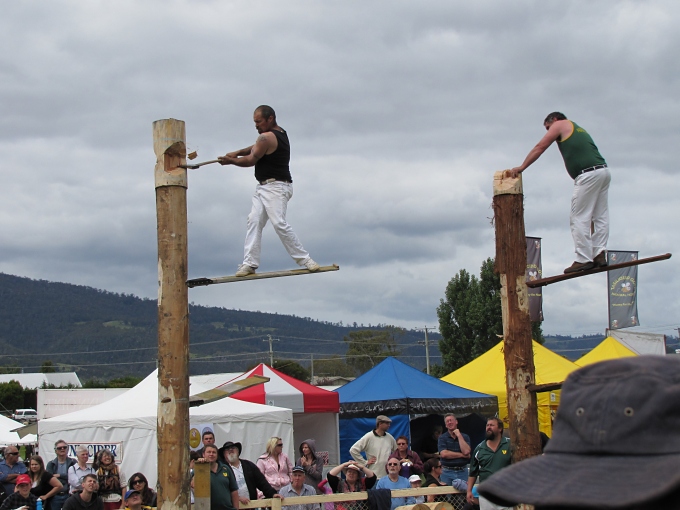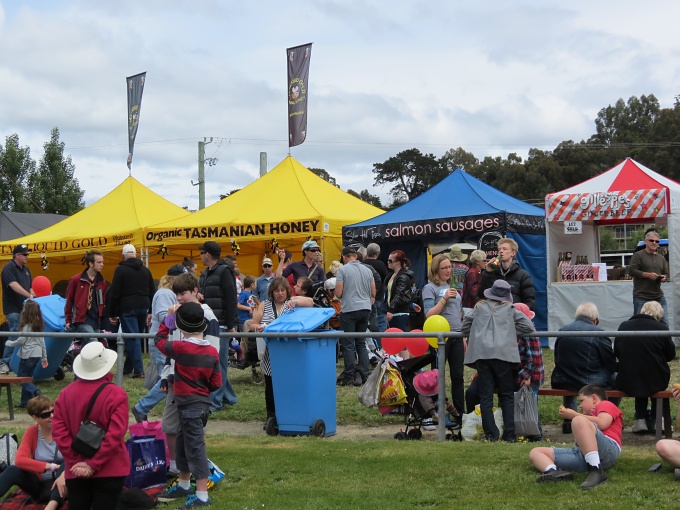66th Annual Huon Show
/ It seems that a celebration as big as a birthday should not be confined to a single day and so it was that the celebration continued. The 66th annual Huon Show was recommended to us as a “real” Tasmanian show. Americans would know it as a county fair. It was overcast, but we were still in celebration mode, so off we went to the Ranelagh show grounds near Huonville.
There was that air of expectancy and excitement as we walked past the animals being unloaded from crates, trucks and vans. All the critters were coiffed and ready to compete. We could hear the noise from the midway. The earthy aroma of manure blended with the odor of deep-fried carnival food, permeating the morning air.
It seems that a celebration as big as a birthday should not be confined to a single day and so it was that the celebration continued. The 66th annual Huon Show was recommended to us as a “real” Tasmanian show. Americans would know it as a county fair. It was overcast, but we were still in celebration mode, so off we went to the Ranelagh show grounds near Huonville.
There was that air of expectancy and excitement as we walked past the animals being unloaded from crates, trucks and vans. All the critters were coiffed and ready to compete. We could hear the noise from the midway. The earthy aroma of manure blended with the odor of deep-fried carnival food, permeating the morning air.
 I had read a short program description and we were most interested in the competitive woodchopping events. Huon pine is endemic to Tasmania and lumbering was a huge industry here when the early “piners” exploited the stands of this slow-growing, long-living, durable tree. The modern sport of woodchopping is said to have had its birth in Ulverstone, Tasmania in 1870 as the result of a £25 ($50) bet between two axemen as to who could first fell a tree. The world's first woodchopping championship was held in 1891 at Bell's Parade, Latrobe, Tasmania, now the home of The Australian Axemen's Hall of Fame and Timberworks. Though similar lumberjacking competitions take place in the US, we'd never attended one.
I had read a short program description and we were most interested in the competitive woodchopping events. Huon pine is endemic to Tasmania and lumbering was a huge industry here when the early “piners” exploited the stands of this slow-growing, long-living, durable tree. The modern sport of woodchopping is said to have had its birth in Ulverstone, Tasmania in 1870 as the result of a £25 ($50) bet between two axemen as to who could first fell a tree. The world's first woodchopping championship was held in 1891 at Bell's Parade, Latrobe, Tasmania, now the home of The Australian Axemen's Hall of Fame and Timberworks. Though similar lumberjacking competitions take place in the US, we'd never attended one.
 How could we have known how many events would be involved in a woodchopping competition? There was chopping, sawing, climbing, felling ... singles, doubles, jack and jills, relays. Handicaps were assigned to contestants in most events. This was serious. We'd watch, then wander off to admire draft horses or check out the goats and pigs, horse jumping or dog's playing flyball, then come back for more woodchopping events.
How could we have known how many events would be involved in a woodchopping competition? There was chopping, sawing, climbing, felling ... singles, doubles, jack and jills, relays. Handicaps were assigned to contestants in most events. This was serious. We'd watch, then wander off to admire draft horses or check out the goats and pigs, horse jumping or dog's playing flyball, then come back for more woodchopping events.
 The most exciting event was the three-board tree felling competition. The axemen ascended a standing pole by making scarfs (notches) in the side of the pole into which they wedged narrow planks to stand on, working their way to the top of the pole. At the top, they chopped a wood block half way through, then scampered down, removing the planks as they descended. They started the whole process again on the other side of the pole to complete the chop through of the block at the top. We were exhausted watching the energy expended during this competition that lasted only a few minutes.
The most exciting event was the three-board tree felling competition. The axemen ascended a standing pole by making scarfs (notches) in the side of the pole into which they wedged narrow planks to stand on, working their way to the top of the pole. At the top, they chopped a wood block half way through, then scampered down, removing the planks as they descended. They started the whole process again on the other side of the pole to complete the chop through of the block at the top. We were exhausted watching the energy expended during this competition that lasted only a few minutes.
 We watched as blue ribbons were presented to the best-fleeced alpacas, the cutest cows, the most handsome roosters, the tastiest cakes, the best contribution by a senior citizen (??), the highest jump by a dog … there was absolutely no lack of high end entertainment. A country-western band crooned throughout the day...hopefully they had not given up their day jobs. One display was entitled “Old Bits and Pieces”. We couldn't tell if “old bits and pieces” referred to the old men sitting around or the various old machines that chugged away next to them.
We watched as blue ribbons were presented to the best-fleeced alpacas, the cutest cows, the most handsome roosters, the tastiest cakes, the best contribution by a senior citizen (??), the highest jump by a dog … there was absolutely no lack of high end entertainment. A country-western band crooned throughout the day...hopefully they had not given up their day jobs. One display was entitled “Old Bits and Pieces”. We couldn't tell if “old bits and pieces” referred to the old men sitting around or the various old machines that chugged away next to them.
 There was a midway in small town carnival fashion offering huge plush toys in exchange for beaucoup bucks and the opportunity to test your skills. We could hear the screams from the kids getting whipped around in the more adventuresome amusement rides. All sorts of food was offered. Tornado potatoes, spirals of deep fried potatoes on a stick, were popular. More Tasmanian offerings like salmon burgers and Valhalla ice cream had waiting lines. Kids were sticky with fairy floss (cotton candy) and cranky with fatigue and too much sugar by day's end.
There was a midway in small town carnival fashion offering huge plush toys in exchange for beaucoup bucks and the opportunity to test your skills. We could hear the screams from the kids getting whipped around in the more adventuresome amusement rides. All sorts of food was offered. Tornado potatoes, spirals of deep fried potatoes on a stick, were popular. More Tasmanian offerings like salmon burgers and Valhalla ice cream had waiting lines. Kids were sticky with fairy floss (cotton candy) and cranky with fatigue and too much sugar by day's end.
The show lasted only one day and was breaking down by 5pm. The finale included a “ute muster” (lots of pick-up trucks on display...wow!) and a Grand Parade in which horses, cows, alpacas, pigs, sheep, trucks, tractors, lawn mowers and basically anything capable of moving in line, participated. There were even wood chippers and wooden boats on trailers for this grand event.
All in all, a fine way to end my annual celebration. Wonder where we'll be next year at this time?

